Concealed pipe leaks are one of the most challenging plumbing issues homeowners face. Because these leaks occur within walls, floors, or ceilings, they often go unnoticed until significant damage has occurred. Left unchecked, concealed leaks can lead to structural damage, mold growth, and increased water bills. Understanding how to identify and repair these hidden leaks early is essential to maintaining a safe and healthy home.
If you suspect you have a hidden leak, engaging professional concealed pipe leakage repair services is advisable. Experts in this field have the tools and experience to locate leaks without unnecessary demolition and to carry out effective repairs that prevent further damage.
Signs of Concealed Pipe Leaks
Detecting concealed leaks requires careful observation because visible water is often absent. Here are common signs that indicate you might have a hidden pipe leak:
- Unexplained Increase in Water Bills: If your water consumption rises without any obvious reason, a concealed leak might be the cause.
- Damp or Discolored Walls and Ceilings: Persistent damp patches, bubbling paint, or stains on walls or ceilings often suggest water seepage behind surfaces.
- Musty or Moldy Odors: Mold thrives in damp conditions, so a musty smell can be a telltale sign of hidden leaks.
- Sound of Running Water: If you hear water running when no taps are open, it could indicate a pipe leak inside a wall or floor.
- Low Water Pressure: A leak can cause a drop in water pressure throughout your home.
Noticing one or more of these signs should prompt immediate investigation to avoid costly damage.
Causes of Concealed Pipe Leaks
Several factors contribute to the development of concealed pipe leaks:
- Corrosion: Over time, metal pipes can corrode, leading to small cracks or holes that leak water.
- Poor Installation: Improperly installed pipes or fittings can become loose or damaged, causing leaks.
- Age of Plumbing System: Older plumbing systems are more prone to wear and tear, increasing the risk of leaks.
- Shifts in Building Structure: Structural movements or vibrations may damage concealed pipes.
- Clogged or Blocked Pipes: Pressure buildup behind blockages can cause pipes to burst or leak.
Understanding these causes can help you take preventive measures and act promptly when problems arise.
How Professionals Detect Concealed Pipe Leaks
Detecting concealed leaks is often difficult without professional tools. Some common methods used by experts include:
- Thermal Imaging Cameras: These detect temperature changes caused by moisture, pinpointing leaks behind walls or floors.
- Acoustic Leak Detectors: These devices pick up the sound of water escaping pipes, even if it’s faint.
- Pressure Testing: Technicians measure water pressure to identify drops that indicate a leak.
- Moisture Meters: These help locate damp areas within walls or ceilings.
Professional detection minimizes damage since it avoids unnecessary wall or floor removal and ensures the leak is accurately located.
Effective Concealed Pipe Leakage Repair Techniques
Once a concealed leak is located, effective repair methods depend on the severity and type of pipe involved:
- Spot Repair: Small leaks or cracks can sometimes be fixed by patching or sealing the damaged section without replacing the pipe.
- Pipe Relining: This technique involves inserting a resin-coated liner inside the existing pipe, creating a new pipe within the old one without digging up walls or floors.
- Pipe Replacement: In cases of severe damage or corrosion, replacing the damaged pipe segment is necessary.
- Waterproofing and Restoration: After repair, affected areas should be treated for moisture and restored to prevent mold growth and maintain aesthetics.
Hiring experienced plumbers who specialize in concealed pipe leakage repair ensures the use of appropriate techniques for long-lasting results.
Preventive Measures to Avoid Concealed Leaks
Prevention is always better than repair. Here are some steps homeowners can take to reduce the risk of concealed pipe leaks:
- Regular Plumbing Inspections: Schedule routine checks to catch early signs of wear or damage.
- Maintain Proper Water Pressure: High water pressure strains pipes, increasing leak risk; use pressure regulators if needed.
- Quality Installation: Always hire licensed professionals to install or upgrade plumbing systems to ensure durability.
- Use Corrosion-Resistant Materials: Modern pipes made from materials like PEX or PVC have better resistance to corrosion.
- Prompt Repairs: Address minor leaks or plumbing issues immediately to prevent escalation.
By adopting these preventive measures, you can safeguard your home from hidden water damage.
Conclusion
Concealed pipe leaks pose serious risks to your home’s structure and your family’s health, making early identification and timely repair crucial. Recognizing the warning signs, understanding common causes, and relying on professional concealed pipe leakage repair services are the best ways to tackle this problem effectively. With the right detection methods and repair techniques, you can preserve the integrity of your home and avoid costly damages. Regular maintenance and vigilance are key to ensuring your plumbing system remains leak-free and efficient for years to come.



